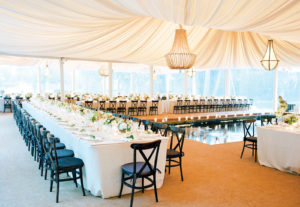
Tent liners, pole covers and swags aren’t just for concealing unattractive elements. Fabric decor provides a way to maximize an event’s excitement.
The primary purpose of tent liners, pole covers and swags or drapes has always been to conceal the structure of a tent as unobtrusively as possible, allowing more glamorous design elements to bask in the spotlight. But these event staples have become stars in their own right, expanding the tools available to event planners and designers tasked with creating unforgettable events.
Consider fabric. Geri Sims, owner of Geri Sims Drapery, looks at fabric as providing the way for the event to come to life and exceed expectations. “It’s 80 percent of the look in a tent,” she says. Located in Atlanta, Ga., Sims’ company specializes in draped walls and ceiling designs for weddings and other events. She finds that clients, whether wedding or corporate, want more than just a typical tent—they want something unique.
“When it comes to decorating with fabric, the sky is the limit,” Sims says. “Fabric has staying power because we’ve yet to expand on everything that can be done. What fabric is doing now, and will continue to do within the tent industry, is allowing us to think outside of the box.”
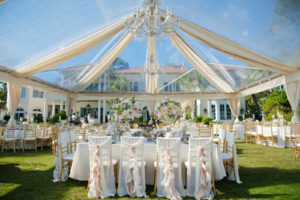
Turn poles into assets
For some events, the design strategy calls for making poles an integral part of the experience. John Hensel, senior event designer for HMR Designs, a Chicago, Ill.-based event design and production firm, describes a tented wedding for which his company transformed the poles into trees, which branched out over the dance floor.
“We then hung a medley of crystal chandeliers from the center of the tent and ‘painted’ the entire interior with botanical texture lighting that began as amber and pale candlelight tones, and then evolved into vibrant and energetic hues that complemented the music,” Hensel says. “The result was an enchanting, forest-like atmosphere, rustic but refined.”
Other tactics HMR Designs has deployed involve covering the poles in rope to match other rope decor accents such as rope chandeliers and frames. “We find ways to turn poles into assets when the atmosphere requires it,” he says.
John Fuchs, general manager, special events, for Anchor Industries Inc., Evansville, Ind., is seeing customers wrapping strands of twinkling lights around poles, then placing a pole cover over the lights. “The twinkling lighted poles now become the center points of the space underneath the tent, rather than objects renters once tried to hide and minimize,” he says. Anchor offers a range of customized fabric covers for pole and frame tents, and as is the case with liners, the most requested color is white.
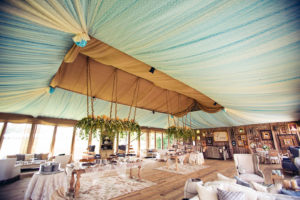 Celina Tent Inc., Celina, Ohio, has developed its own product line of center pole and leg drapes as well as tent liners. Cassandra Roessner, marketing and printing coordinator for Celina, says that many of the company’s customers use leg and center pole drapes to hide tubing and poles without using a tent liner.
Celina Tent Inc., Celina, Ohio, has developed its own product line of center pole and leg drapes as well as tent liners. Cassandra Roessner, marketing and printing coordinator for Celina, says that many of the company’s customers use leg and center pole drapes to hide tubing and poles without using a tent liner.
“They will then often add decorative tooling, flowers or lights around the horizontal tubing at the tent’s eave,” she says. “This keeps the cost low, while still giving a lively, sophisticated feel to the event.”
For elegant weddings or events, customers tend to prefer leg drapes, which are easier and faster to install than pole covers, especially because they can be installed after the tent is erected (pole covers must be installed before). Pole covers, particularly disposable ones, which Celina also offers, are better suited for more casual affairs such as graduation or birthday parties, Roessner says.
Liner looks
“Tent draping has become a key element to many clients and event planners,” says Sebastian Alonso, design consultant with Beachview Event Rentals & Design. “Years ago, the main role of draping was to hide metal frames only, but now it’s becoming a whole new way to style tents.” With offices in Woodbine, Ga., and Jacksonville, Fla., Beachview is a full-service event rental and design firm.
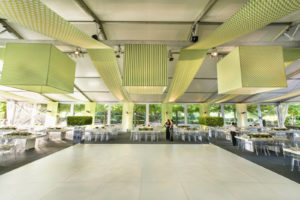 Beachview’s wedding clients are gravitating toward earthy and organic fabrics and elegant sheers, coordinating these natural tones with carpeted floors and tablecloths for a cozy feel. But at the same time, gold and metallic fabrics are popular, Alonso adds. For Beachview’s corporate events, nudes, blues and grays are favored for ceiling and leg drapes and are usually combined with a contemporary color palette.
Beachview’s wedding clients are gravitating toward earthy and organic fabrics and elegant sheers, coordinating these natural tones with carpeted floors and tablecloths for a cozy feel. But at the same time, gold and metallic fabrics are popular, Alonso adds. For Beachview’s corporate events, nudes, blues and grays are favored for ceiling and leg drapes and are usually combined with a contemporary color palette.
Hensel of HMR Designs notes that interest in fabric treatments for higher-end events seems to be waning and that HMR is using less of this than they used to. “We have, however, used oversized fabric shades and patterned panels recently for a gala to achieve a fresh, vibrant look,” he says.
Alternately, Roessner has noticed a rising demand for liners and drapes, prompting Celina to increase its inventory levels for both. Fuchs is seeing the same demand, noting a trend for liners at non-wedding events such as golf tournaments and corporate parties. These venues are also using more pole covers and swags.
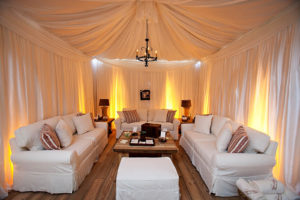 “Historically, these items were only desired for the intimacy of weddings,” Fuchs says. “But corporate events being held under tents feel more high-end thanks to the use of liners and swag.” These are still primarily white, he adds, but different colored swags can support a company logo or holiday theme. Swags may also be used to create an accent stripe or to add depth to tents for both wedding and non-wedding events, Fuchs says. Fabric is also being used to create more intimate spaces within the tents, such as lounge areas.
“Historically, these items were only desired for the intimacy of weddings,” Fuchs says. “But corporate events being held under tents feel more high-end thanks to the use of liners and swag.” These are still primarily white, he adds, but different colored swags can support a company logo or holiday theme. Swags may also be used to create an accent stripe or to add depth to tents for both wedding and non-wedding events, Fuchs says. Fabric is also being used to create more intimate spaces within the tents, such as lounge areas.
Although Anchor doesn’t carry swags (Anchor carries gathered and contoured/smooth liners and pole covers), Fuchs says he’s heard that when party rental companies add these to their inventory, their sales significantly increase and they are able to move into higher-end events. When used in addition to tent liners, swags and drapes help contribute to the overall intimate feel many customers want today—more like a room than a tent, he says.

Liner illumination
Non-wedding events tend to favor a contoured, tight-fitted liner, with a preference for a smooth, clean appearance and feel, Fuchs says. For weddings, the rustic and vintage decor trends remain strong. Lights are often placed behind liners for a softened and intimate yet still illuminated space. Placing lights behind the liner is happening more frequently, Roessner says. Colored gels over PAR lighting, which change the shade of the tent liner, complementing the palette of the event, are also popular.
Using swag and liners in conjunction with wood accents as a structural element is trending for Classic Party Rentals, says Susan Kidwell, vice president and general manager with Classic Party Rentals San Francisco, based in Burlingame, Calif.
“It can be structural when cladding poles are used with wood,” she says. “This is a way for clients to bring in color, or they can enhance with florals. Ultimately, we’re trying to eliminate the feeling of entering a tent, evoking a feeling of entering a beautifully designed space instead.”
As for tent liners, what is requested depends on the event, Kidwell says. For corporate events, flat liners are often preferred for their contemporary look. However, the classic, full-pleated liner hasn’t lost ground, especially for weddings. Most of Kidwell’s clients are opting to customize their events via fabrics and colors complementing their design, rather than selecting prefabricated liners.
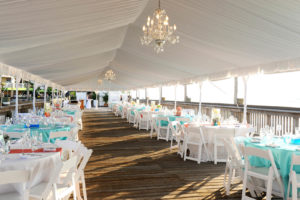 For fabrics, muslins, sheers and Camelot/faux silks are frequently chosen. Although the traditional and timeless events still drive demand, Classic’s corporate clients increasingly request glamping (“glamorous camping”) decor, Kidwell says. Rustic chic and midcentury modern decor remain popular for all kinds of events, weddings included.
For fabrics, muslins, sheers and Camelot/faux silks are frequently chosen. Although the traditional and timeless events still drive demand, Classic’s corporate clients increasingly request glamping (“glamorous camping”) decor, Kidwell says. Rustic chic and midcentury modern decor remain popular for all kinds of events, weddings included.
Fabrics provide endless possibilities for creativity. “It’s amazing what you can do in a tent with fabrics,” Alonso says. “They can be specially styled to match the client’s vision for any occasion. Today’s creative designers are opting not only for tented ballrooms but also additional tents such as lounges, walkways and entrances.
“Draping can really make a change in your tent rental business; it’s very profitable and brings the entire event design together,” he says.
Pamela Mills-Senn is a freelance writer based in Long Beach, Calif.
Liners and swags can represent a sizable investment for rental companies. Proper cleaning, storage and handling of these items are essential to maximize ROI. John Fuchs, general manager, special events, for Anchor Industries, recommends washing tent liners in cold water with a mild detergent, then air-drying them. Never use hot water or high heat because these could shrink the thread in fabric liners. Fold and store contoured liners carefully to avoid wrinkling.
It is vital to store liners and drapes only when they’re completely dry, cautions Cassandra Roessner, marketing and printing coordinator for Celina Tent Inc. Storing even just slightly damp liners and drapes can result in mildew and discoloration that can’t
be removed.
Always store liners with the valance edges at the bottom of the bag and the center hub assembly at the top, Rossner says. “This makes attaching the rope and pulley to the line easier and also prevents the liner from dragging on the ground where it may get dirty or damaged,” she says.
 TEXTILES.ORG
TEXTILES.ORG


